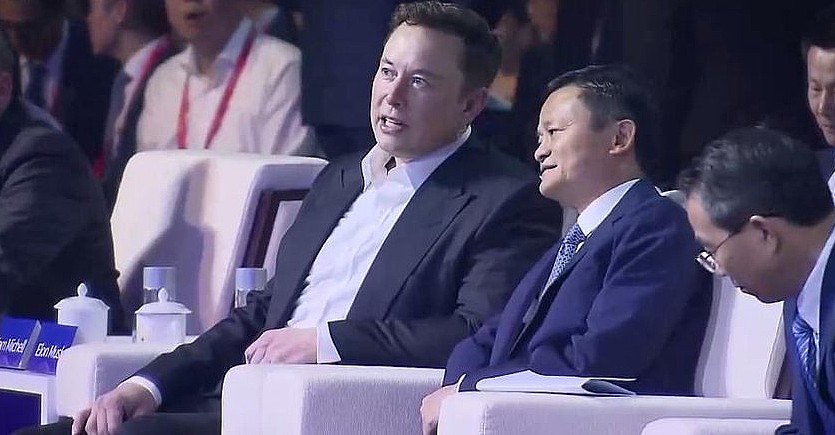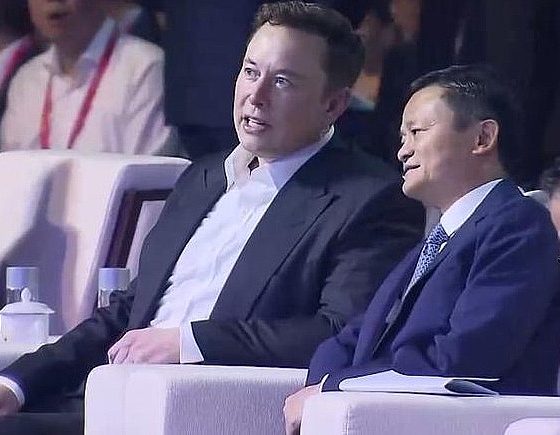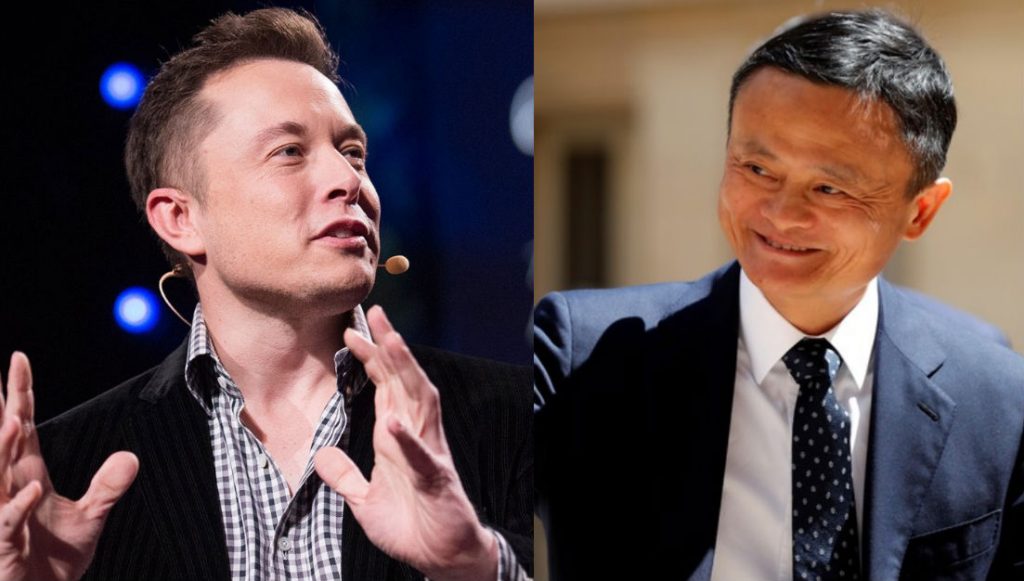

News
Elon Musk and Jack Ma discuss AI’s risks, Mars, and how humans can secure the future
Tesla and SpaceX CEO Elon Musk and Alibaba founder and Chairman Jack Ma kicked off the 2019 World Artificial Intelligence Conference in Shanghai, China, with an informal debate about AI and its implications to humanity. Throughout their conversation, Musk and Ma touched on several topics, from jobs, the need for educational reform, moving to Mars, and how humans’ way of life can improve in the future.
Opposing Views
The two billionaires have vastly differing points of view concerning artificial intelligence. While Musk is cautious about AI considering the dangers it may pose to humanity, Ma is far more optimistic. “I don’t think AI is a threat,” Ma said, responding to the Tesla CEO’s introductory points. Explaining further, the Alibaba founder noted that people are “street smart,” and thus, humanity will be fine even when AI evolves. Musk, for his part, doubled down on his point, arguing that AI’s rate of improvement is notable, and there will come a time when computers will outpace humans’ natural ability to understand it.
Making humans multi-planetary
Musk noted that humans have an opportunity today because this is the first time in history that it’s “possible to extend life beyond Earth.” He added that the window for this could either be open for a long or short time. Thus, it is in humanity’s best interest to secure its multi-planetary opportunities as quickly as possible.
Ma, for his part, argued that he has no interest in multi-planetary initiatives. “I’m not a fan of going to Mars,” he noted. Instead, Ma stated that it’s more pertinent for humans to try and preserve Earth. The Alibaba chairman nevertheless stated that the world needs innovators like Elon Musk, in as much as it needs people who are willing to do what needs to be done to save the planet. “We need heroes like you (who want to go to Mars), but we need heroes like us (who will fix Earth),” Ma said.
Musk explained that preserving Earth is a notable part of Tesla’s mission, from transitioning the transportation sector towards sustainability to fostering energy independence through solar power and batteries. Responding to Ma’s statements about using resources to focus on solving Earth’s problems, Musk noted that it will only take a fraction of the world’s GDP to make humans multi-planetary, comparable or even less than what people spend on something like makeup annually. “Spending resources on making life multi-planetary would be enough with just 1% of the earth’s GDP,” Musk noted.
AI’s threat to jobs
“Why do we need that many jobs anyway?” Ma said, explaining that humans have been fearing that tech will take jobs away for over a hundred years, and yet, jobs have increased. Ma believes that with AI’s help, humans can eventually reach a point where the average workweek is only 3 days per week, and the average workday is only 4 hours a day. This, according to Ma, opens the opportunity for humans to enjoy life more, and live even longer. “We need to be ready to enter the era where everyone will get to live 120 years,” he said.
Musk, for his part, stated that the advent of AI will likely make most jobs pointless. Considering AI’s evolution, Musk noted that the time will come when computers could eventually make their own software. With this in mind, it would be best for people to embrace areas such as engineering and fields of study that deal with human relations, as these will still be pertinent even in the artificial intelligence age. The Tesla CEO added that this is the reason behind Neuralink and its brain-machine interface, as it will prevent humans from being left behind.
The need for education reform
The Alibaba founder admitted that he is worried about the current educational system, which is still largely designed for the industrial period. Ma argues that today, there is a need to foster more creative and constructive education, which would allow humans to live a happier life. “I want to spend more time training kids on painting, singing, dancing, these creative things that make people live like humans,” he said. Ma added that people have heart, and that is where wisdom comes from. With this in mind, it is best for education to focus on training this aspect of the human being.
The Tesla CEO agreed that creative education is needed, particularly as today’s school system is “low bandwidth and extremely slow.” Musk noted that solutions such as Neuralink’s neural lace could be a difference-maker in this sense, as it would allow people to upload skills and learn them quickly, in a manner that is not too far from the concepts depicted in the sci-fi franchise The Matrix.

The dangers of AI
While the two disruptors agreed that there is a need for educational reform, Musk and Ma disagreed most about the potential risks of AI. Ma argued that compared to humans, computers are just a toy, adding that the best resource in the world is the human brain. “It’s impossible that humans could be controlled by machines. They’re machines that are invented by humans,” Ma said.
Musk noted that he very much disagrees with Ma’s stance. Arguing his point, the Tesla CEO stated that humans are capable of creating things that are superior to people. Humans are not the last step in evolution, Musk said, and people must be wary of thinking that they are smarter than they really are. “The most important mistake smart people make is that they think they’re smart. Computers are already smarter than people. We just keep moving the goalposts,” he stated.
Responding to Musk’s argument, Ma noted that the metrics humans use to benchmark themselves against AI (such as world champions in Chess playing against artificial intelligence) do not make sense, as games like Go are designed for human minds. “Why should humans play against computers? It’s stupid to compete with computers,” Ma quipped, adding that while computers can be clever, humans are smarter and wiser.
The future of humanity
Musk believes that one of the world’s greatest threats lie in its declining birthrate. “The world’s biggest issue in 20 years is population collapse,” he said, adding that this could be a big issue considering that humans generally have a “20-year boot sequence.” Ma agreed, stating that even China’s population, which currently stands at 1.4 billion people, sounds a lot today, but if one factors in the country’s declining birthrate, the country will see a completely different landscape in 20 years.
Musk added that more humans are definitely needed, especially with the start of multi-planetary initiatives. “Mars needs people,” he lightly said.
Ma ultimately believes that pursuing AI is wise to make people’s lives better. The Alibaba founded added that artificial intelligence can always do a better job when logic is involved, but when logic is not involved, humans will always be better. To thrive in the future, Ma stated that humans need not just IQ, but emotional intelligence, and (love) intelligence as well. Musk nodded, stating “I agree with him. Love is the answer.”
Watch Elon Musk and Jack Ma’s informal AI debate in the video below.

Elon Musk
Elon Musk’s X will start using a Tesla-like software update strategy
The initiative seems designed to accelerate updates to the social media platform, while maintaining maximum transparency.

Elon Musk’s social media platform X will adopt a Tesla-esque approach to software updates for its algorithm.
The initiative seems designed to accelerate updates to the social media platform, while maintaining maximum transparency.
X’s updates to its updates
As per Musk in a post on X, the social media company will be making a new algorithm to determine what organic and advertising posts are recommended to users. These updates would then be repeated every four weeks.
“We will make the new 𝕏 algorithm, including all code used to determine what organic and advertising posts are recommended to users, open source in 7 days. This will be repeated every 4 weeks, with comprehensive developer notes, to help you understand what changed,” Musk wrote in his post.
The initiative somewhat mirrors Tesla’s over-the-air update model, where vehicle software is regularly refined and pushed to users with detailed release notes. This should allow users to better understand the details of X’s every update and foster a healthy feedback loop for the social media platform.
xAI and X
X, formerly Twitter, has been acquired by Elon Musk’s artificial intelligence startup, xAI last year. Since then, xAI has seen a rapid rise in valuation. Following the company’s the company’s upsized $20 billion Series E funding round, estimates now suggest that xAI is worth tens about $230 to $235 billion. That’s several times larger than Tesla when Elon Musk received his controversial 2018 CEO Performance Award.
As per xAI, the Series E funding round attracted a diverse group of investors, including Valor Equity Partners, Stepstone Group, Fidelity Management & Research Company, Qatar Investment Authority, MGX, and Baron Capital Group, among others. Strategic partners NVIDIA and Cisco Investments also continued support for building the world’s largest GPU clusters.
News
Tesla FSD Supervised wins MotorTrend’s Best Driver Assistance Award
The decision marks a notable reversal for the publication from prior years, with judges citing major real-world improvements that pushed Tesla’s latest FSD software ahead of every competing ADAS system.

Tesla’s Full Self-Driving (Supervised) system has been named the best driver-assistance technology on the market, earning top honors at the 2026 MotorTrend Best Tech Awards.
The decision marks a notable reversal for the publication from prior years, with judges citing major real-world improvements that pushed Tesla’s latest FSD software ahead of every competing ADAS system. And it wasn’t even close.
MotorTrend reverses course
MotorTrend awarded Tesla FSD (Supervised) its 2026 Best Tech Driver Assistance title after extensive testing of the latest v14 software. The publication acknowledged that it had previously criticized earlier versions of FSD for erratic behavior and near-miss incidents, ultimately favoring rivals such as GM’s Super Cruise in earlier evaluations.
According to MotorTrend, the newest iteration of FSD resolved many of those shortcomings. Testers said v14 showed far smoother behavior in complex urban scenarios, including unprotected left turns, traffic circles, emergency vehicles, and dense city streets. While the system still requires constant driver supervision, judges concluded that no other advanced driver-assistance system currently matches its breadth of capability.
Unlike rival systems that rely on combinations of cameras, radar, lidar, and mapped highways, Tesla’s FSD operates using a camera-only approach and is capable of driving on city streets, rural roads, and freeways. MotorTrend stated that pure utility, the ability to handle nearly all road types, ultimately separated FSD from competitors like Ford BlueCruise, GM Super Cruise, and BMW’s Highway Assistant.
High cost and high capability
MotorTrend also addressed FSD’s pricing, which remains significantly higher than rival systems. Tesla currently charges $8,000 for a one-time purchase or $99 per month for a subscription, compared with far lower upfront and subscription costs from other automakers. The publication noted that the premium is justified given FSD’s unmatched scope and continuous software evolution.
Safety remained a central focus of the evaluation. While testers reported collision-free operation over thousands of miles, they noted ongoing concerns around FSD’s configurable driving modes, including options that allow aggressive driving and speeds beyond posted limits. MotorTrend emphasized that, like all Level 2 systems, FSD still depends on a fully attentive human driver at all times.
Despite those caveats, the publication concluded that Tesla’s rapid software progress fundamentally reshaped the competitive landscape. For drivers seeking the most capable hands-on driver-assistance system available today, MotorTrend concluded Tesla FSD (Supervised) now stands alone at the top.
News
Elon Musk’s Grokipedia surges to 5.6M articles, almost 79% of English Wikipedia
The explosive growth marks a major milestone for the AI-powered online encyclopedia, which was launched by Elon Musk’s xAI just months ago.

Elon Musk’s Grokipedia has grown to an impressive 5,615,201 articles as of today, closing in on 79% of the English Wikipedia’s current total of 7,119,376 articles.
The explosive growth marks a major milestone for the AI-powered online encyclopedia, which was launched by Elon Musk’s xAI just months ago. Needless to say, it would only be a matter of time before Grokipedia exceeds English Wikipedia in sheer volume.
Grokipedia’s rapid growth
xAI’s vision for Grokipedia emphasizes neutrality, while Grok’s reasoning capabilities allow for fast drafting and fact-checking. When Elon Musk announced the initiative in late September 2025, he noted that Grokipedia would be an improvement to Wikipedia because it would be designed to avoid bias.
At the time, Musk noted that Grokipedia “is a necessary step towards the xAI goal of understanding the Universe.”
Grokipedia was launched in late October, and while xAI was careful to list it only as Version 0.1 at the time, the online encyclopedia immediately earned praise. Wikipedia co-founder Larry Sanger highlighted the project’s innovative approach, noting how it leverages AI to fill knowledge gaps and enable rapid updates. Netizens also observed how Grokipedia tends to present articles in a more objective manner compared to Wikipedia, which is edited by humans.
Elon Musk’s ambitious plans
With 5,615,201 total articles, Grokipedia has now grown to almost 79% of English Wikipedia’s article base. This is incredibly quick, though Grokipedia remains text-only for now. xAI, for its part, has now updated the online encyclopedia’s iteration to v0.2.
Elon Musk has shared bold ideas for Grokipedia, including sending a record of the entire knowledge base to space as part of xAI’s mission to preserve and expand human understanding. At some point, Musk stated that Grokipedia will be renamed to Encyclopedia Galactica, and it will be sent to the cosmos.
“When Grokipedia is good enough (long way to go), we will change the name to Encyclopedia Galactica. It will be an open source distillation of all knowledge, including audio, images and video. Join xAI to help build the sci-fi version of the Library of Alexandria!” Musk wrote, adding in a later post that “Copies will be etched in stone and sent to the Moon, Mars and beyond. This time, it will not be lost.”








